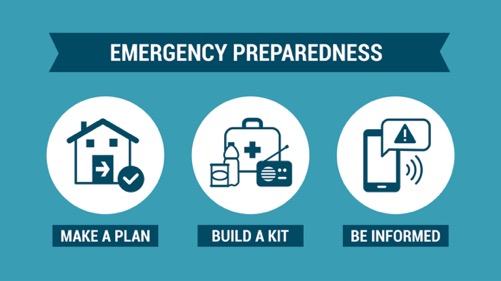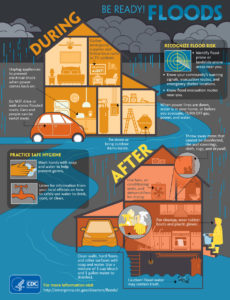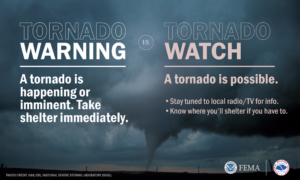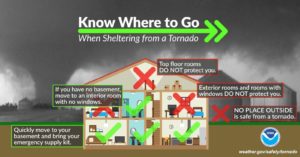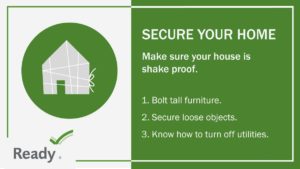Jump to Topic:
Hurricanes | Floods | Tornadoes | Earthquakes | General Storm Safety | Power Outages
natural disasters preparedness GUIDE
hurricanes
Extremely dangerous and can cause major damage due to storm surge, wind damage and flooding
what should you know?
- Know what to do before, during, and after a hurricane (Español)
- Prepare before hurricane season starts. Pacific hurricane season starts May 15 and Atlantic hurricane season starts June 1.
- Create an emergency communication plan with your family before a hurricane.
- Have emergency supplies in place at home, at work and in the car.
- Check your insurance coverage, damages caused by flooding are not covered under normal homeowner’s insurance policies.
- Know your community’s evacuation plan , possible evacuation routes and how to sign up for local alerts.
prepare your home 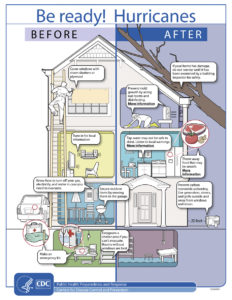
- Always run generators outdoors to prevent carbon monoxide poisoning
- Fill up your car’s gas tank, park in garage, if possible
- Cover windows with hurricane shutters or plywood
- Secure outdoor objects or bring them inside
- Keep all trees and shrubs well-trimmed
prepare your family
- Check your emergency supplies for your family and pets
- Make or review your plans for your pets in preparation for an event you would need to shelter-in-place or evacuate
- Monitor advisories, watches, and warnings on local TV stations
- Consider discussing a family plan for securing outdoor property in days prior to landfall for a predicted hurricane
- Know where you plan to go if evacuation is ordered, and as a last resort know where your county shelter is located
- Somerset County shelter is at Washington High School and does accept pets
stay safe after
- Listen to local officials for information and special instructions
- Be careful during clean up. Wear protective clothing, use appropriate face masks or coverings, and maintain a physical distance of at least 6 feet while working
- Do not touch electrical equipment if it is wet or you are standing in water
- Avoid wading in flood water, which can contain dangerous debris
- Save phone calls for emergencies
- Document property damage with photographs
- Engage with your family and community virtually
additional resources:
- Tip Sheets
- More Information
floods
Flooding is a temporary overflow of water onto land that is normally dry. Floods are the most common natural disaster in the United States. Failing to evacuate flooded areas or entering flood waters can lead to injury or death.
Floods may:
- Result from rain, snow, coastal storms, storm surges and overflows of dams and other water systems.
- Develop slowly or quickly. Flash floods can come with no warning.
- Cause outages, disrupt transportation, damage buildings and create landslides.
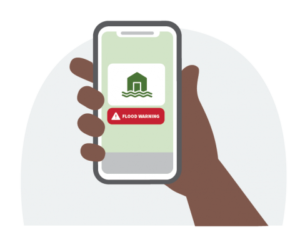
If you are under a flood warning:
- Find safe shelter right away.
- Do not walk, swim or drive through flood waters. Turn Around, Don’t Drown!
- Remember, just six inches of moving water can knock you down, and one foot of moving water can sweep your vehicle away.
- Stay off bridges over fast-moving water.
- Depending on the type of flooding:
- Evacuate if told to do so.
- Move to higher ground or a higher floor.
- Stay where you are.
prepare now
Preparing for a Flood
Make a plan for your household, including your pets, so that you and your family know what to do, where to go, and what you will need to protect yourselves from flooding. Learn and practice evacuation routes, shelter plans, and flash flood response. Gather supplies, including non-perishable foods, cleaning supplies, and water for several days, in case you must leave immediately or if services are cut off in your area.
In Case of Emergency
Keep important documents in a waterproof container. Create password-protected digital copies. Protect your property. Move valuables to higher levels. Declutter drains and gutters. Install check valves. Consider a sump pump with a battery.
Know Your Risk for Floods
Visit FEMA’s Flood Map Service Center to know types of flood risk in your area. Sign up for your community’s warning system. The Emergency Alert System (EAS) and National Oceanic and Atmospheric Administration (NOAA) Weather Radio also provide emergency alerts.
Purchase Flood Insurance
Purchase or renew a flood insurance policy. Homeowner’s insurance policies do not cover flooding. It typically takes up to 30 days for a policy to go into effect so the time to buy is well before a disaster. Get flood coverage under the National Flood Insurance Program (NFIP).
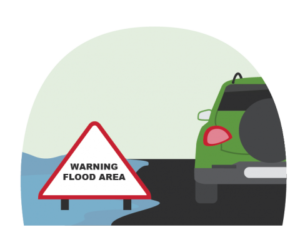
stay safe during
- Evacuate immediately, if told to evacuate. Never drive around barricades. Local responders use them to safely direct traffic out of flooded areas.
- Contact your healthcare provider If you are sick and need medical attention. Wait for further care instructions and shelter in place, if possible. If you are experiencing a medical emergency, call 9-1-1.
- Listen to EAS, NOAA Weather Radio or local alerting systems for current emergency information and instructions regarding flooding.
- Do not walk, swim or drive through flood waters. Turn Around. Don’t Drown!
- Stay off bridges over fast-moving water. Fast-moving water can wash bridges away without warning.
- Stay inside in your if it is trapped in rapidly moving water. Get on the roof if water is rising inside the car.
-
-
-
-
-
-
-
-
-
- Get to the highest level if trapped in a building. Only get on the roof if necessary and once there signal for help.
- Do not climb into a closed attic to avoid getting trapped by rising floodwater.
-
-
-
-
-
-
-
-
-
stay safe after 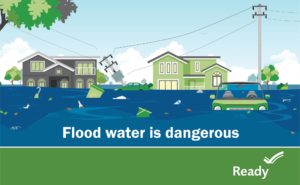
- Pay attention to authorities for information and instructions. Return home only when authorities say it is safe.
- Avoid driving except in emergencies.
- Wear heavy work gloves, protective clothing and boots during clean up and use appropriate face coverings or masks if cleaning mold or other debris.
- People with asthma and other lung conditions and/or immune suppression should not enter buildings with indoor water leaks or mold growth that can be seen or smelled. Children should not take part in disaster cleanup work.
- Be aware that snakes and other animals may be in your house.
- Be aware of the risk of electrocution. Do not touch electrical equipment if it is wet or if you are standing in water. Turn off the electricity to prevent electric shock if it is safe to do so.
- Avoid wading in floodwater, which can be contaminated and contain dangerous debris. Underground or downed power lines can also electrically charge the water.
- Use a generator or other gasoline-powered machinery ONLY outdoors and away from windows.
ADDITIONAL RESOURCES:
TORNADOES
Violent rotating columns of air that extend from a thunderstorm causing deadly flying debris and extreme damage to buildings and cars.
They can happen at any time bringing intense winds, sometimes over 200 miles per hour.
prePARE NOW:
- Know your area’s risk for tornadoes
- In Maryland the most common time for a tornado to occur is April through November and most happen from 3pm to 9pm.
- Sign up for your community’s warning system
- Pay attention to weather reports
- Local news stations broadcast when there are severe weather warnings or watches
- Some safe shelters include a safe room, storm shelter, or an interior, windowless room or basement on the lowest level of a sturdy building
- Know the signs: dark, greenish sky; large hail; large, dark, low-lying cloud; loud roar (similar to a freight train)
- Plan for your pet
- Build an emergency kit and create a family communications plan
- The kit should include: emergency supplies, cleaning supplies, non-perishable foods, water, medical supplies, and medication. Pack enough items for a long-term period without power or running water.
stay safe DURING
- Immediately go to a safe place that you have identified
- Do NOT open windows or doors
- If you live in a mobile home, get out immediately, and go to a safe shelter or the lowest floor of a nearby sturdy building
- Protect yourself by covering your head or neck with your arms and putting material like furniture or blankets around or on top of you
- If you are outside with no shelter
- Watch out for flying debris
- Do not hide under an overpass or bridge. You are safer in a low flat area
- Immediately get into a vehicle, buckle your seatbelt and try to drive to the nearest safe shelter
- Never try to outrun a tornado in congested areas in a car or truck. Instead, leave the vehicle immediately and go to a safe shelter
stay safe AFTER
- Pay attention to local authorities and continue to monitor your battery-powered radio or television for updated emergency information
- Save phone power for emergency calls, text or post only
- Be aware of any structural, electrical or gas-leak hazards in or around your home
- If you suspect any damage, shut off electrical power, natural gas and propane tanks
- If you smell gas or suspect a leak, turn off gas valve, open windows, leave the house, and call 911 and notify the gas company
- Do not return to house until you are told it is safe
- Stay clear of any fallen power lines or broken utility lines
- Wear appropriate gear such as thick-soled shoes, work gloves or face face mask during clean-up
Additional Resources:
earthquakes
An earthquake is a sudden, rapid shaking of the ground caused by the shifting of rocks deep underneath the earth’s surface. Earthquakes can cause fires, tsunamis, landslides or avalanches. While they can happen anywhere without warning, areas at higher risk for earthquakes include Alaska, California, Hawaii, Oregon, Puerto Rico, Washington and the entire Mississippi River Valley.
prepare now
- Practice Drop, Cover, and Hold On with family and coworkers.
- Make an Emergency Plan: Create a family emergency communications plan that has an out-of-state contact. Plan where to meet if you get separated. Make a supply kit that includes enough food and water for several days, a flashlight, a fire extinguisher and a whistle.
- Protect Your Home: Secure heavy items in your home like bookcases, refrigerators, televisions and objects that hang on walls. Store heavy and breakable objects on low shelves. Consider making improvements to your building to fix structural issues that could cause your building to collapse during an earthquake. Consider obtaining an earthquake insurance policy. A standard homeowner’s insurance policy does not cover earthquake damage.

DROP, COVER, AND HOLD ON
1. Drop (or Lock)
Wherever you are, drop down to your hands and knees and hold onto something sturdy. If you’re using a wheelchair or walker with a seat, make sure your wheels are locked and remain seated until the shaking stops.
2. Cover
Cover your head and neck with your arms. If a sturdy table or desk is nearby, crawl underneath it for shelter. If no shelter is nearby, crawl next to an interior wall (away from windows). Crawl only if you can reach better cover without going through an area with more debris. Stay on your knees or bent over to protect vital organs.
3. Hold On
If you are under a table or desk, hold on with one hand and be ready to move with it if it moves. If seated and unable to drop to the floor, bend forward, cover your head with your arms and hold on to your neck w
using a cane, walker or wheelchair? follow the steps below:



stay safe after
- Wash your hands with soap and water after holding on to commonly touched surfaces or objects. If you are unable to wash your hands, use hand sanitizer that contains at least 60 percent alcohol.
- Expect aftershocks to follow the main shock of an earthquake. Be ready to Drop, Cover, and Hold On if you feel an aftershock.
- If you are in a damaged building, go outside and quickly move away from the building. Do not enter damaged buildings.
- If you are trapped, send a text or bang on a pipe or wall. Cover your mouth with your shirt for protection and instead of shouting, use a whistle.
- Check yourself to see if you are hurt and help others if you have training.
Once you are safe, pay attention to local news reports for emergency information and instructions via battery-operated radio, TV, social media or from cell phone text alerts.
Additional Resources:
Tip Sheets
- Earthquake Informational Poster
- How to Prepare for an Earthquake
- Resources for People With Disabilities
General storm safety tips
Storm Injury Prevention
AROUND FLOOD WATER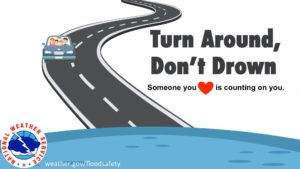
- Turn around, don’t drown! Never drive on flooded roads. Water may be deeper than it appears.
- Wear a life jacket near water. In rising flood waters, wear a U.S. Coast Guard-approved life jacket/personal flotation device. Select the correct life jacket for the person’s weight and size (printed on the label).
- If you own a private well, have it tested before resuming use after a flood.
outdoors
- Avoid loose or dangling power lines. Do not touch! Report them to the proper authorities immediately.
cleaning up
- Wear sturdy shoes or boots and protective clothing including long sleeves, heavy pants, and gloves when cleaning debris.
- Wear eye protection if you are using a chainsaw. Watch for eye-level debris that could be harmful.
- Be careful using power tools or clearing large debris. Large items may shift suddenly.
- Falls are common. Don’t take chances!
electrical dangers: fire & carbon monoxide
- Don’t get burned. If you are using a camp stove or fire to cook, pay attention and avoid distractions.
- Avoid carbon monoxide dangers when the electrical power is off in your home.
- Only use charcoal or gas grills in an open, well-ventilated area and never inside the home. Keep the grill away from flammable materials, such as deck railing or awnings.
- Gasoline-powered generators should never be used in an enclosed area, such as a basement or garage. Make sure the area is well-ventilated, dry, and covered.
- Do not connect a generator to your home’s electrical system.
- Connect appliances directly to the generator using properly-sized polarized extension cords. Do not overload the generator. Secure the extension cords to avoid trips and falls.
- Be sure the generator is properly grounded (follow the manufacturers directions).
- Before refueling, let the engine cool for at least two minutes to prevent a fire.
staying safe around animals and pets
- Use an insect repellent containing DEET to reduce the risk of mosquito-borne illness.
- Survey the are before beginning clean-up. Insects such as bees and wasps can become aggressive after a storm. Use pesticide if needed.
- Watch for snakes. They may be found in unexpected places after a storm or flood.
- Use caution around pets. Animals can be frightened after a storm. Be careful around domestic animals like dogs and cats, especially if you do not know them. Avoid contact with wild animals.
family safety: returning home
- Do not leave children unattended. Do not allow them to play in or explore damaged or flooded areas. Keep hazardous materials out of reach, including cleaning/disinfecting chemicals, fuel for generators, and pest control substances.
- Check for structural damage before entering a building. Do not enter if there is danger of collapse.
- Turn off outside gas lines at the meter or tank. Let the house air for a few minutes.
- If the neighborhood electricity is off, it is still important to turn off the main breaker or fuse box. If you have to step in water to get to the breaker box, call a professional electrician for advice.
- Do not turn on lights, appliances, or gas systems until they’ve been tested.
- If you must enter at night, use a battery-operated flashlight, never an open flame.
POWER OUTAGES
prepare now
- Store emergency supplies in your home, including a first aid kit, canned food and a manual opener), bottled water, flashlight, battery-operated radio and any essential prescription drugs. Make sure you know how to shut off gas, water and electric supplies at the source in your ho
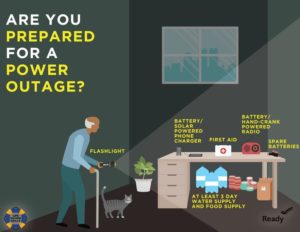 use. Keep a fire extinguisher in the house.
use. Keep a fire extinguisher in the house. - Tell the police department and fire department ahead of time if you have a person living in your home who needs special assistance. Locate emergency shelters in your community in case you need assistance during a power outage.
stay safe during
- Carbon monoxide can kill you even though you can’t see it and you can’t smell it. So the best way to protect yourself is to prevent carbon monoxide from building up in the first place. What’s the best way to do this during a power outage? Don’t use the following inside of your home without ventilation: barbeque or camp grills, gasoline engines, generators, lanterns and gas ranges. Using these
indoors could lead to a poisonous buildup of air in the house. If you must use any of these appliances, be sure to open lots of windows first. Also, don’t burn any charcoal and wood in your home with the windows shut.- If power is out for a long time, don’t eat any food in your refrigerator that is warmer than 40 degrees (°F) as measured by a food thermometer.
- Drink plenty of water if the weather is hot. But first call your local water company to make sure the water from your faucet is safe to drink while you are waiting for the power to go back on.
- If it’s cold outside, wear lots of clothing to keep warm.
- Don’t touch any power lines either on the roof of your home or on the ground
- Even if there’s no power in your home, there may still be live wires. If someone in your home gets an electrical shock, don’t touch them or the source of the shock! Use cardboard, wood or plastic to move the live wire away from the person. Once you have moved the electrical source, check the person’s pulse, call 911 and start CPR if necessary. If a person looks weak, lay her or him down and elevate the person’s legs.
stay safe after
- Check with your neighbors and see if they have power turned back on. If not, offer to assist them in any way you can. Make sure that your water is clean before drinking or bathing in it. Also check the temperature of the food in your refrigerator before eating it: When in doubt, throw it out.
generator safety
Facts sheets to help you:
What to do for a Boil Water Advisory
Mold Issues
For more on food safety visit websites such as:
- Guidelines for Cleaning Safely After a Disaster
- What to Do to Prevent Getting Hurt or Sick After a Disaster

